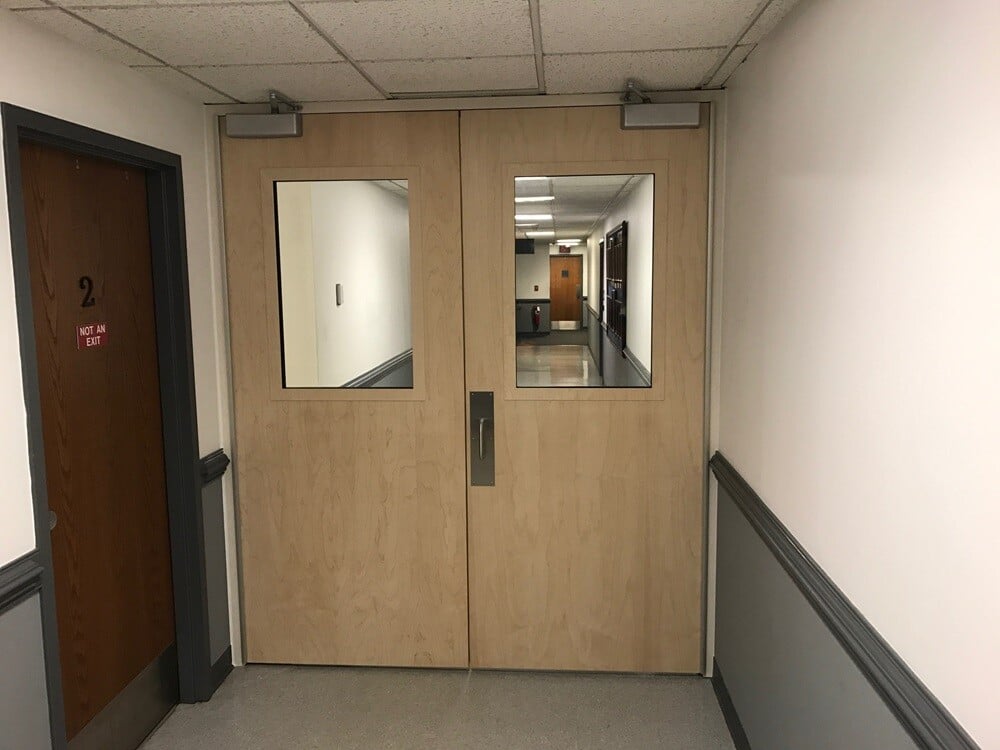No. Regardless of what you’ve seen in a movie, a wood door won’t stop a bullet. That is, unless you’ve invested in ballistic wood doors. And facilities increasingly are doing just that.
In the last 18 months, Total Security Solutions has seen an increase in demand for bulletproof wood doors that look just like non-rated wood doors. In this blog, we’ll break down how real bulletproof doors are made and why they’ve become such a popular bulletproof barrier.
Ballistic Fiberglass Makes a Wood Door Bulletproof
Because wood isn’t strong enough to stop a bullet on its own, we use bulletproof fiberglass to make doors ballistic and a wood veneer to maintain a beautiful, natural wood appearance. These doors look just like any other wood door, but can stop shots from handguns and rifles, depending on the level of protection. UL Levels 1, 2, and 3 can stop handgun shots; Levels 4, 5, 6, 7, and 8 can stop rifle fire.
To fabricate a Level 1 through 3 ballistic door, we start with a standard solid core wood door blank. Then, we adhere ballistic fiberglass on the threat side of the door, which adds between 0.25” and 0.5” to the door’s total thickness. We then veneer the door to match the current decor or existing doors.
Bulletproof doors at Levels 1, 2, and 3 are slightly thicker than unrated doors. So, in most cases, the existing frame’s stops can be moved to accommodate that thickness and keep the face of the door from extending past the frame or casing. If the original frame can’t be adjusted, TSS can shave down the wood door to make it the correct thickness, backfilling any areas with fiberglass. The result is indistinguishable from the original, unrated door.
Bulletproof wood doors at Levels 4 through 8 have a bullet-resistant fiberglass panel as the core, rather than wood. These panels range in thickness from roughly 1.25” to 1.5,” depending on the level of protection. We then skin the fiberglass with masonite on both sides, which gives a wood-like working surface. After that, the door is covered in wood veneer before being prepped for installation and delivery. Because bulletproof wood doors at Level 4 through 8 are heavier and thicker than non-rated wood doors, they require a special frame, hinges, and closer that are designed to withstand the extra weight and remain easy to operate.
Why There’s an Increasing Demand for Bulletproof Wood Doors
Bulletproof wood doors are the most popular ballistic door at TSS, overtaking bulletproof aluminum doors in the last 18 months. Two industries driving this trend are healthcare and religious organizations such as churches and synagogues. However, this trend isn’t going away anytime soon; in fact, we expect other industries to follow their lead, which means having more bulletproof doors in place in other types of facilities.
More people are looking for bulletproof wood doors for four reasons:
- More organizations are looking for defense at depth, not limiting bulletproof barriers to the building entrances. Now, organizations are making sure guests have safe shelters in more situations, and fallback positions in an emergency.
- They need to maintain the historic character of the building while improving safety and security. In these cases, TSS’s experience working in historic buildings is extremely valuable.
- They want “stealth security,” reinforcing C-suites or conference rooms without creating alarm or suggesting to the public that there are ballistic barriers in place.
- They value the daily user experience: no one wants going to the office or attending a religious service to feel like entering a vault or prison.
We understand how important aesthetics are and how much those visual messages mean. That’s why we go above and beyond to match your bulletproof wood doors to your existing, non-rated doors. There doesn’t have to be a trade off where you are safer, but don’t feel more comfortable.
Want to Learn More? Download the Ballistic Doors Solutions Guide
We’re pleased to make free materials available to support good security planning. That includes our comprehensive Ballistic Doors Solutions Guide. If you have any questions, or are ready to begin moving forward with a project, we’re here to help. Contact us to get started.

